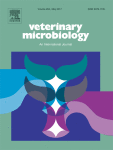Ver ítem
- xmlui.general.dspace_homeCentros e Institutos de InvestigaciónCICVyA. Centro de Investigación en Ciencias Veterinarias y AgronómicasInstituto de VirologíaArtículos científicosxmlui.ArtifactBrowser.ItemViewer.trail
- Inicio
- Centros e Institutos de Investigación
- CICVyA. Centro de Investigación en Ciencias Veterinarias y Agronómicas
- Instituto de Virología
- Artículos científicos
- Ver ítem
Discovery and molecular characterization of a group A rotavirus strain detected in an Argentinean vicuña (Vicugna vicugna)
Resumen
The wild vicuña (Vicugna vicugna) is one of the four species of native South American camelids (SACs) in addition to the wild guanaco, and their domesticated counterparts, alpaca and llama, respectively. Serological data have indicated the presence of group A rotaviruses (RVA) specific antibodies in all 4 members of the SAC, and so far, RVA has been detected from alpacas, llamas and guanacos. A total of 59 fecal samples from healthy wild newborn and
[ver mas...]
The wild vicuña (Vicugna vicugna) is one of the four species of native South American camelids (SACs) in addition to the wild guanaco, and their domesticated counterparts, alpaca and llama, respectively. Serological data have indicated the presence of group A rotaviruses (RVA) specific antibodies in all 4 members of the SAC, and so far, RVA has been detected from alpacas, llamas and guanacos. A total of 59 fecal samples from healthy wild newborn and juvenile vicuñas, raised in captivity in Jujuy, Argentina were collected and analyzed by ELISA to detect RVA antigen. Two samples (3%) were found to contain G8 RVA strains and one strain (RVA/Vicuña-wt/ARG/C75/2010/G8P[14]) was selected for further genome analyses, revealing the G8-P[14]-I2-R2-C2-M2-Ax-N2-T6-E3-Hx genotype constellation. Unfortunately, no sequence data could be obtained for NSP1 and NSP5. Except for the E3 NSP4 genotype, this partial genotype constellation is reminiscent to bovine RVA strains and bovine-like RVA strains isolated from sheep, guanaco, antelope and humans. This relationship was confirmed phylogenetically, providing further evidence of the widespread presence of this genotype constellation in animals belonging to the artiodactyls. In particular, a close phylogenetic relationship was found between C75 and guanaco RVA strain RVA/Guanaco-wt/ARG/Chubut/1999/G8P[14] for at least 5 gene segments, suggesting a partial conservation of the genotype constellation of RVA strains infecting different species of SACs, even though nowadays their natural habitats are not overlapping. The further monitoring of the sanitary health of wild newborn and juvenile vicuñas is essential to improve the management practices applied in their sustainable exploitation.
[Cerrar]

Autor
Badaracco, Alejandra;
Matthijnssens, Jelle;
Romero, Sandra Raquel;
Heylen, Elisabeth;
Zeller, Mark;
Garaicoechea, Lorena Laura;
Van Ranst, Marc;
Parreño, Gladys Viviana;
Fuente
Veterinary Microbiology 161 (3–4) : 247-254 (January 2013)
Fecha
2013-01-25
Editorial
Elsevier
ISSN
0378-1135
Formato
pdf
Tipo de documento
artículo
Palabras Claves
Derechos de acceso
Restringido
 Excepto donde se diga explicitamente, este item se publica bajo la siguiente descripción: Creative Commons Attribution-NonCommercial-ShareAlike 2.5 Unported (CC BY-NC-SA 2.5)
Excepto donde se diga explicitamente, este item se publica bajo la siguiente descripción: Creative Commons Attribution-NonCommercial-ShareAlike 2.5 Unported (CC BY-NC-SA 2.5)

